Genre: Platformer Developer: Sega Technical Institute Publisher: Sega Enterprises Players: 1 Released: 1992
I have bone to pick with Sonic the Hedgehog . Sure, that title did a lot for platformers, giving Mario a run for his money as well as a shot in the arm for a sagging genre. However, he also opened the door for hundreds of wannabe mascots with “attitude.” Some were able to pull it off, most weren’t.
Kid Chameleon is one title that mostly managed to make things work, with only a few snags. Your character, a sunglass and leather jacket-wearing delinquent, is the baddest boy in town. He’s so bad that he spends all of his time just hanging out at the local arcade. Given his attire and demeanor (the manual labels him as “the toughest, coolest head in town”); I was at least hoping he’d take someone’s lunch money in the intro. No such luck.
While aimlessly loitering, Kid is called upon to save all the other little truants from a new game called Wild Side. It seems that the machine zaps gamers a la Tron and only Kid is left to save them all from the evil designs of Heady Metal (you heard me right). My question is: if Kid is such a badass, why is he mixed up in such a lame plot?
Unlike all the others who were taken prisoner, Kid has special powers that give him the edge in Wild Side’s virtual world. Fast and agile, he can use helmets scattered throughout each area to transform into several characters, ranging from a samurai to a Jason look-alike. Most are very cool to look at and each has its own ability that must be used at some point to pass on to the next stage. The Micromax helmet, for example, allows you to stick to walls and spring up to out of reach places, whereas the Juggernaut helmet transforms you into a tank that mows down foes with skull bombs. There are about nine helmets in all, which gives you freedom to explore the huge areas, and there are a lot of them. My favorite has to be the Eyeclops helmet, which not only looks cool, but lets you light up invisible blocks with a huge energy ray.
In addition to a standard attack, each helmet has a second power that uses up diamonds you must collect by bumping blocks in Marioesque fashion. You’ll also find continue icons, clocks to add to your available time (up to 9:59), and 1ups. You will need each and every item you find if you want to finish the exhaustive quest thrust upon you here. More on that later.
A platformer is nothing without good control and KC is solid in this regard. Using what at first looks like a typical three button scheme (running, jumping & attacking), the game expands a bit by using simple button combinations for special attacks (e.g. speed button +start) and flipping onto platforms (jump x2). Nothing big to be sure, but it’s a welcome change from the many “push right and run to the end” builds common to the era.
Taking a look at the game, it’s no wonder Kid hides behind all those masks. There isn’t a lot of meat on these bones, although what is there does a decent enough job. Minimal parallax doesn’t do much to get you excited, but the character designs are nice and well-drawn, with nice little touches of detail such as the tiny beating wings that come with the Mircromax helmet. There’s decent use of color as well. While the overall package is nothing to write home about visually, it’s not going to kill you either. I found the whole game to be more or less on par graphically with a solid Turbo Grafx-16 title, as opposed to some of the eye candy powerhouses that were on the Genesis at the time.
I have mixed feelings about the level design. Some stages are too straight forward, giving little incentive for exploration. You just plow on through with a certain helmet until you reach the flag at the end. Other stages are absolutely huge (very sweet), forcing you to use up what little time is allotted to you in search of much-needed items. Exploration is nice and all, but not when it’s done in three minute blocks. Some jumps, especially the ones on spring blocks, require much patience and time and the clock really works against you in these situations.
To me, the music in a platformer shouldn’t simply be an afterthought. Just about everyone can remember tunes from any Mario or Sonic game; they lodge themselves in your brain and stay put. The music in Kid Chameleon is not only forgettable, it’s depressing. As I write this, not a single song comes to mind, save for the highly generic intro theme. I don’t know why the music is so bad but it hurts the experience greatly. It’s also pretty low, which makes things even worse. I suspect the developers were striving for the same effect found in games like Strider or Spider-Man , where the low music builds up to a dramatic splash in certain areas. There is, however, no part of KC that even remotely emulates the feel of rushing down a snow covered mountain with a trail of explosions behind you, or swinging through Central Park with Venom in hot pursuit.
The sounds aren’t as bad, but won’t exactly knock your socks off. You’d think that since all the action takes place inside of an arcade game, there would be at least a few sounds reminiscent of that type of environment. Guess again. I understand that Wild Side is supposed to be a whole virtual experience, but c’mon!
So, we have an average looking platformer with bad audio and some decent gameplay elements. Almost sounds like an afternoon, right? Better make it the whole weekend. Remember the exhaustive quest I mentioned earlier? It’s about 103 levels long, clocking in at about 1,850 screens. You’ll need to put your social life on hold if you plan on beating this game. Is it that hard, you ask? Not really. The difficulty isn’t a problem at all. It’s the sheer length of the game that makes beating it such a problem. See, there aren’t any passwords or saves. You must beat the entire thing in a single sitting. Prior to writing this review, I played for over an hour and got almost halfway through. Now, I love long challenges as much as the next guy, but the simple oversight of not including a password is impractical to say the least. Should you be determined to play it through, I recommend locking your door, taking the phone off the hook, and investing in a UPS. God forbid there should be a power surge or outage while you’re playing.
Honestly, since all the helmets and items are found in-stage and nothing is carried over from one area to another, a simple four character password seemed to be a given here. Playing it with a friend could also pose a problem, time-wise. Can you imagine sitting through this while alternating between players after each stage? 206 stages all at once? Not likely.
It’s a shame, really. The concept is good enough, and there is plenty of exploration and gameplay to have made Kid Chameleon a must-have. However, the lackluster graphics and sound, hindered by the immense length, take it down a notch.
SCORE: 8 out of 10

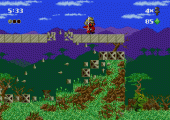
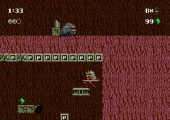
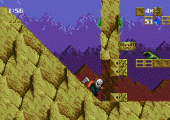
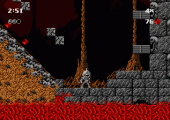
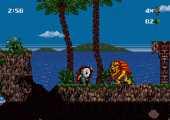
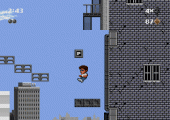
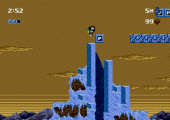
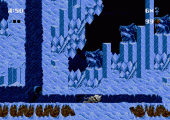
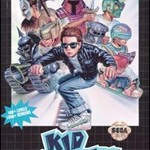
This is a game that defined cool when it was released in the early ’90s. When I finally had my own money and decided to buy it around 2002, I realized what I’d been missing out on. This is a very fun and challenging game and feels definitively SEGA. It’s a quirky platformer that takes risks, and is loaded with fun and secrets. I’m decidedly not good at this game, but it’s still a blast to pop in now and then and revisit. All the unique suits give the player lots of options and make you feel empowered, and that’s why I find it so fun.
I enjoyed playing through this game, but I never played from start to finish. I eventually found a secret warp (thanks GameFAQs) in the 2nd or 3rd stage that takes you to the last Shishkaboss (yeah, funny name, funny-looking boss). It’s a game you should play through…when you’ve done everything else on your bucket list.